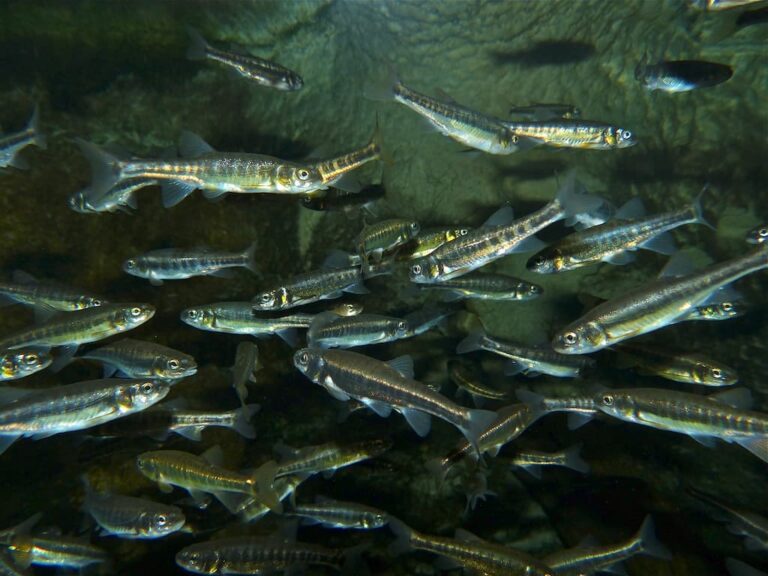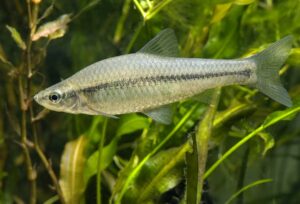Panfish : Minnow (Phoxinus phoxinus)

The Minnow fish, scientifically known as Phoxinus phoxinus, is a well-known species among anglers who enjoy coarse fishing, thanks to its straightforward fishing techniques.
This small freshwater fish becomes easily recognisable once its features have been closely observed. During the breeding season, the male minnow exhibits a distinctive feature by adorning itself with bright spots of blue and red. This fish holds significant appeal for predators and those with a taste for its delicate flesh.

What are Minnow fish (Phoxinus phoxinus) ?
A Minnow fish (Phoxinus phoxinus) is a small freshwater cyprinid fish species commonly found in North America and Eurasia. These small fish are known for their slender bodies and typically grow to an average size of 2-4 inches (5-10 centimeters) in length. They are often used as bait fish and are an important part of the aquatic food chain.
Minnow fish description
Determination
The Minnow fish, scientifically known as Phoxinus phoxinus, is a small freshwater fish characterised by its elongated cylindrical body. It has a relatively large head with a rounded snout. Its tiny mouth is slightly upward-facing, and the upper jaw is slightly longer than the lower jaw.
The minnow’sfins are rounded, with a relatively high dorsal fin and a deeply forked tail fin. The back of this fish displays a colouration ranging from brown to olive green. Its sides are silver and adorned with black, blue, and yellow stripes, giving it its name derived from the Latin word “varius,” meaning “spotted.”
There is a golden spot on its gill covers, and during the breeding season, males develop a red hue on their otherwise grey-white bellies. The minnow boasts tiny, numerous, and discreet scales covering its body.
| Class |
| Actinopterygii |
| Order |
| Cypriniformes |
| Family |
| Cyprinidae |
| Genus |
| Phoxinus |
| Species |
| P. phoxinus |
| Binomial Name |
| Phoxinus phoxinus (Linnaeus, 1783) |
Size and Weight
As mentioned earlier, minnows are relatively small fish, with an average size ranging from 2 to 4 inches (5 to 10 centimetres) in length. They typically weigh between 0.1 to 0.5 ounces (3 to 14 grams), making them a popular choice for anglers as bait fish.
Minnow fish (Phoxinus phoxinus) habitat and distribution
Minnows are native species from North America and Eurasia, found in various freshwater habitats such as streams, rivers, and lakes. They prefer clear, cool waters with moderate to fast flow and are often found in areas with gravel or rocky substrates.
Minnows thrive in areas with plenty of aquatic vegetation, providing shelter and protection from predators. They are adaptable to a wide range of water conditions, from slightly acidic to slightly alkaline, and can tolerate temperatures from 0 to 25 degrees Celsius. This adaptability contributes to their widespread distribution and abundance in their natural habitats.
Minnow diet and feeding habits
These small fish are omnivorous and feed on various food sources, including aquatic insects, small crustaceans, and algae. They also consume small fish eggs and fry, making them an important part of the aquatic food web.
Breeding
Minnows typically spawn in the spring and early summer, with males developing breeding tubercles. They lay their eggs in shallow gravel nests. Minnows are known for their prolific breeding, with females capable of producing hundreds of eggs in a single spawning event.
The eggs are adhesive and stick to the substrate, where the males fertilise them. Once hatched, the young minnows grow rapidly and reach sexual maturity within a year. Their ability to reproduce quickly and adapt to various environmental conditions makes them a resilient and important species in freshwater ecosystems. Understanding minnows’ habitat, diet, and behaviour is crucial for conservation efforts and sustainable management of their populations in the wild.
Fishing techniques to catch Minnow fish (Phoxinus phoxinus)
Minnows are commonly used as bait for larger game fish such as Bass, Trout, and Zander. They can be caught using various techniques, including a small hook, bait, or minnow trap.
Threats and conservation issues
While minnows are not considered to be a threatened species, they are still vulnerable to habitat degradation, pollution, and overfishing. It is important to practice sustainable fishing practices and protect their natural habitats to ensure their continued survival.
The Minnow fish is classified as “LC” (Least Concern) on the IUCN Red List. This category indicates that it is a widely distributed and abundant species.
Minnows are known for their ability to adapt to various environmental conditions, making them a resilient species in the face of habitat changes. Their presence in freshwater ecosystems also plays a crucial role in controlling insect populations and maintaining the balance of aquatic ecosystems. As a result, conservation efforts are important to ensure the preservation of minnow populations and the health of their natural habitats.
International Names for the Minnow fish (Phoxinus phoxinus)
In addition to being known as the minnow in English, Phoxinus phoxinus has various international names. In German, it is referred to as “Kleiner Fisch” or “Elritze,” while in French, it is known as “Vairon.” In Spanish, it is called “Estrilda común,” and in Italian, it is known as “Fócino.” These international names reflect the widespread distribution of the minnow and its importance in various cultures and ecosystems. Understanding the global significance of the minnow can help promote international cooperation in conservation efforts and sustainable management of its populations.
Types of minnows
There are several minnow species, each with its own unique characteristics and distribution. Some of the common types of minnows include the cheat minnow, cutlips minnow, desert minnows, Eurasian minnows, fathead minnow, loach minnow, and silverjaw minnow, among others.
As food
While primarily used for bait, humans can also eat minnows. Some Native American cultures have used minnows as food; if small enough, they can be eaten whole.






